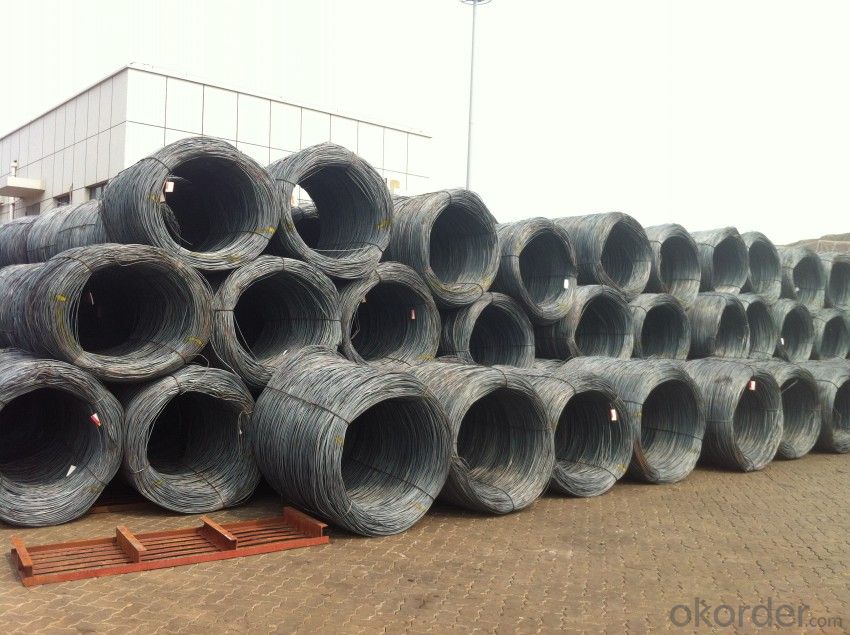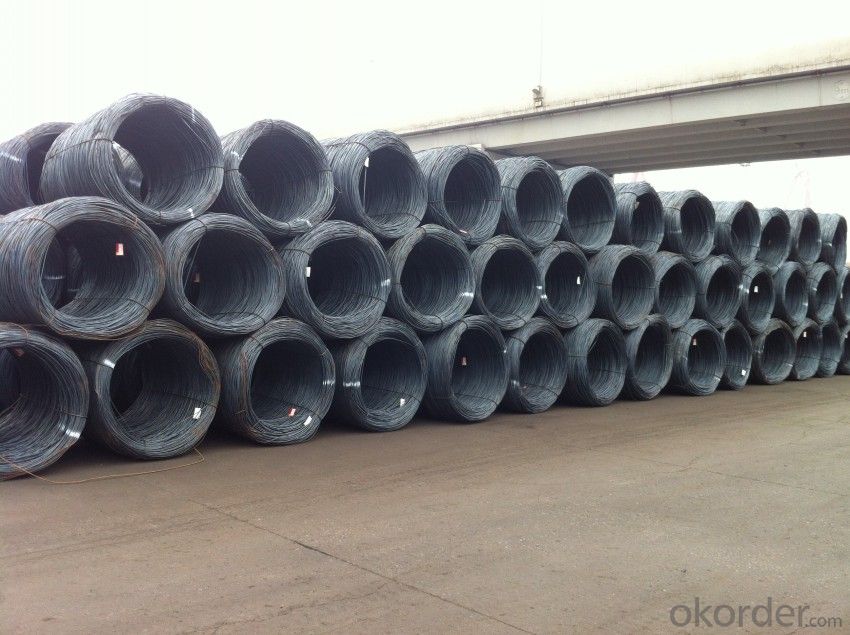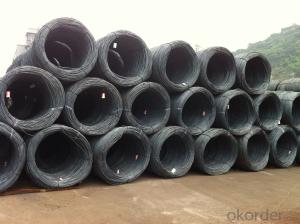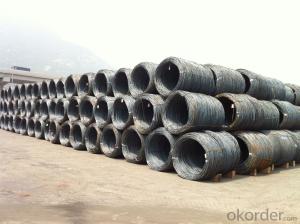Hot Rolled Steel Wire rods in Grade SAE1008B
- Loading Port:
- Tianjin
- Payment Terms:
- TT OR LC
- Min Order Qty:
- 25 m.t
- Supply Capability:
- 10000 m.t/month
OKorder Service Pledge
OKorder Financial Service
You Might Also Like
OKorder is offering Carbon Steel Wire Rod at great prices with worldwide shipping. Our supplier is a world-class manufacturer of steel, with our products utilized the world over. OKorder annually supplies products to European, North American and Asian markets. We provide quotations within 24 hours of receiving an inquiry and guarantee competitive prices.
Product Applications:
Carbon Steel Wire Rod are ideal for structural applications and are widely used in the construction of buildings and bridges, and the manufacturing, petrochemical, and transportation industries.After hot-rolled the products shaped into coil and delivery as finished product, including round, square, rectangular, hexagonal and so on. Since most of the products are round, it is generally called wire rod. Carbon steel wire rod is widely used in construction and manufacturing. Carbon steel wire rod is mainly used for reinforcement of reinforced concrete and welded structure or reprocessed (roberts , nail, etc.) materials, especially used to produce wire drawing, welding electrode, nails, spring, electronic, precise machinery parts and so on.
Product Advantages:
OKorder's Carbon Steel Wire Rod are durable, strong, and resist corrosion.
Main Product Features:
· Premium quality
· Prompt delivery & seaworthy packing (30 days after receiving deposit)
· Corrosion resistance
· Can be recycled and reused
· Mill test certification
· Professional Service
· Competitive pricing
Product Specifications:
Chemical Composition:
Please kindly find our chemistry of our material based on SAE1006/SAE1008 as below for your information
Grade | Chemical Composition (%) | |||||
C | Mn | S | P | Si | B | |
SAE1006B | 0.03~O.07 | 0.32max | 0.045max | 0.040max | 0.30max | 0.0008min |
Mechanical properties | ||||||
Yield strength(N/mm2) | Tensile strength(N/mm2) | Elongation (%) | ||||
250-280 | 350-380 | ≥32 | ||||
Grade | Chemical Composition (%) | |||||
C | Mn | S | P | Si | B | |
SAE1008B | 0.10max | 0.3~0.50 | 0.050max | 0.040 max | 0.15max | 0.0008 min |
Mechanical properties | ||||||
Yield strength(N/mm2) | Tensile strength(N/mm2) | Elongation (%) | ||||
≥195 | 315-430 | ≥30 | ||||
FAQ:
Q1: Why buy Materials & Equipment from OKorder.com?
A1: All products offered by OKorder.com are carefully selected from China's most reliable manufacturing enterprises. Through its ISO certifications, OKorder.com adheres to the highest standards and a commitment to supply chain safety and customer satisfaction.
Q2: Can stainless steel rust?
A2: Stainless does not "rust" as you think of regular steel rusting with a red oxide on the surface that flakes off. If you see red rust it is probably due to some iron particles that have contaminated the surface of the stainless steel and it is these iron particles that are rusting. Look at the source of the rusting and see if you can remove it from the surface.
Q3: How soon can we receive the product after purchase?
A3: Within three days of placing an order, we will begin production. The specific shipping date is dependent upon international and government factors, but is typically 7 to 10 workdays.
Image:


- Q:How is steel wire rod stored at the customer's site?
- Steel wire rod is typically stored at the customer's site in a variety of ways depending on the specific requirements and conditions. One common method is to store the steel wire rod on racks or pallets, especially if the customer has a large quantity of rods. These racks or pallets are usually placed in an organized manner to ensure easy accessibility and safety. In addition to racks or pallets, steel wire rod can also be stored in bundles or coils, particularly when the customer requires smaller quantities or wants to maintain the wire rod's shape and integrity. These bundles or coils are often secured with straps or bands to prevent any movement or damage during storage or transportation. Furthermore, the storage area for steel wire rod should be dry, clean, and well-ventilated to prevent corrosion or other forms of damage. Proper protection measures, such as covering the wire rod with tarps or plastic sheets, may be employed to shield it from dust, moisture, or other environmental elements. It is important for customers to follow any specific storage instructions provided by the manufacturer or supplier to ensure the longevity and quality of the steel wire rod. This may include guidelines on temperature control, stacking limitations, or the use of specialized equipment for handling and storage. Overall, the storage of steel wire rod at the customer's site should prioritize safety, accessibility, and protection to guarantee the optimal performance and usability of the product.
- Q:How is steel wire rod used in the production of wire shelving?
- Steel wire rod is used in the production of wire shelving as the primary raw material. It is first shaped and cut into the desired length and thickness, then bent and welded to form the structure of the shelving. The steel wire rod provides strength, durability, and stability to the shelves, ensuring they can support heavy loads and withstand daily use.
- Q:How is steel wire rod used in the manufacturing of wire for elevator counterweights?
- The production of wire for elevator counterweights relies heavily on steel wire rods. These rods, typically made from carbon or alloy steel, undergo a series of manufacturing processes to meet the specific requirements for elevator counterweights. To begin, the steel wire rods are thoroughly cleaned and descaled to eliminate any impurities or surface contaminants. This guarantees that the resulting wire is of the utmost quality and possesses exceptional resistance to corrosion. Subsequently, the rods are drawn through a succession of dies to reduce their diameter and increase their length. This drawing process imparts the desired tensile strength and flexibility to the wire. Following the drawing process, the wire is typically subjected to annealing, which relieves any internal stresses and enhances its ductility. This involves heating the wire to a precise temperature and gradually cooling it. Annealing not only improves the mechanical properties of the wire but also enhances its resistance to fatigue and wear. Once the wire has been drawn and annealed, it undergoes surface treatment procedures such as coating or galvanizing. Coating the wire with a protective layer, such as zinc or epoxy, serves to prevent corrosion and prolong its lifespan. Galvanizing entails immersing the wire in a bath of molten zinc to create a protective zinc coating, which offers excellent corrosion resistance. Finally, the coated or galvanized wire is further processed to achieve the desired shape and size for elevator counterweights. It can be cut into specific lengths or wound onto spools to facilitate easier handling during the manufacturing process. The wire is then utilized to construct the internal structure of elevator counterweights, which are essential for balancing the elevator car and ensuring its smooth operation. In conclusion, steel wire rods play a crucial role in the production of wire for elevator counterweights. They undergo various processes, including cleaning, drawing, annealing, and surface treatment, to produce high-quality wire with the necessary strength, flexibility, and corrosion resistance. This wire is then utilized to construct the internal structure of elevator counterweights, thus ensuring the safe and efficient operation of elevators.
- Q:How are steel wire rods used in the production of wire coat hangers for hanging clothes?
- The durability and strength of steel wire rods make them essential for producing wire coat hangers used to hang clothes. These rods are the primary material for creating the frame and shape of the hangers. To begin, the steel wire rods are cut into the desired length for the coat hangers, ensuring the appropriate size for hanging clothes. Specialized machinery is then used to bend and shape the rods into the classic triangular form commonly associated with coat hangers. Next, the ends of the wire rods are smoothed and rounded off to prevent any sharp edges that could potentially damage clothing. This step is crucial for ensuring the safety of the hangers and avoiding harm to the garments being hung. Once the wire rods have been shaped and smoothed, they undergo a protective coating process, typically using plastic or rubber. This coating serves multiple purposes. Firstly, it prevents rusting or corrosion, ensuring the longevity of the hangers. Additionally, it provides a non-slip surface that helps prevent clothes from slipping off. Finally, the coated wire rods are securely attached to a separate hook at the top, allowing the hangers to be hung on a closet rod or any suitable hanging mechanism. This hook is usually made of either plastic or metal and ensures the stability and functionality of the coat hanger. Overall, steel wire rods are vital in the production of wire coat hangers, providing the necessary strength, durability, and shape for hanging clothes. Their versatility and ability to be shaped and coated make them an ideal material for creating reliable and long-lasting hangers.
- Q:How is steel wire rod used in the manufacturing of tire reinforcement?
- Steel wire rod is used in the manufacturing of tire reinforcement primarily due to its high tensile strength. It is formed into fine wires and then woven or braided into a mesh, which is embedded within the tire's rubber layers. This reinforcement provides added strength and stability to the tire, allowing it to withstand the forces and pressures exerted during driving, ultimately enhancing its durability and safety.
- Q:What are the different types of steel wire rod testing equipment?
- There are several types of steel wire rod testing equipment used to ensure the quality and performance of these materials. Some of the common types of equipment include: 1. Tensile testing machine: This equipment is used to measure the tensile strength of steel wire rods. It applies a pulling force on a sample of the wire rod until it breaks, allowing for the determination of the maximum amount of force the wire rod can withstand. 2. Hardness tester: This instrument measures the hardness of the steel wire rod, which is an important property for determining its strength and durability. There are various types of hardness testers, including Rockwell, Brinell, and Vickers hardness testers, which use different methods to assess the hardness of the material. 3. Ultrasonic testing equipment: Ultrasonic testing is a non-destructive method used to detect internal defects and flaws in steel wire rods. This equipment uses high-frequency sound waves to identify any abnormalities that may affect the quality and integrity of the material. 4. Dimensional measurement tools: These tools are used to measure the dimensions and tolerances of steel wire rods accurately. They can include devices such as micrometers, calipers, and gauges to ensure that the wire rods meet the required specifications. 5. Surface inspection equipment: This equipment is used to visually inspect the surface of the steel wire rods for any defects, such as cracks, scratches, or irregularities. Visual inspection can be done manually or with the help of automated systems that use cameras and computer algorithms to detect and analyze surface defects. 6. Chemical composition analyzer: This equipment is used to determine the chemical composition of the steel wire rods. It analyzes the presence and concentration of various elements, such as carbon, manganese, silicon, and others, to ensure that the wire rods meet the required composition standards. These are just a few examples of the different types of testing equipment used for steel wire rods. Each type plays a crucial role in ensuring the quality, strength, and performance of these materials in various industries, including construction, automotive, and manufacturing.
- Q:How is steel wire rod used in the production of wire shelves and racks?
- Wire shelves and racks rely on steel wire rod as a vital component for their production. This material serves as the primary building block for constructing these storage solutions. To begin, the steel wire rod undergoes processing and drawing to attain the desired shape and size for the shelves and racks. This involves passing the rod through a series of dies and rollers, transforming it into a thinner and more pliable wire form. Once drawn, the wire is then bent, cut, and welded to create the essential elements of the shelves and racks. The wire rods are shaped into grids, frames, and supports, forming the fundamental structure of these storage units. The wire rods also play a crucial role in crafting the mesh or grid patterns that make up the shelving surfaces. These grids allow for the safe storage of various items, preventing them from falling through gaps. Moreover, the steel wire rod provides the necessary strength and durability to the shelves and racks. Its high tensile strength ensures that the shelves can withstand heavy loads without bending or breaking, making them suitable for industrial use where robust storage is required. Furthermore, the steel wire rod is often coated or galvanized to enhance its resistance to corrosion. This protective coating safeguards the shelves and racks from rust and other forms of deterioration, extending their lifespan and preserving their appearance. In conclusion, the utilization of steel wire rod in the production of wire shelves and racks is indispensable. It offers the essential strength, durability, and functionality required for effective storage solutions in a variety of settings, including homes, offices, warehouses, and retail spaces.
- Q:What are the common applications of steel wire rod?
- Steel wire rods have a wide range of applications across various industries. They are commonly used in construction, automotive, manufacturing, and aerospace sectors. Steel wire rods are primarily used for making wire, which is further utilized in the production of nails, screws, springs, cables, and fences. Additionally, they are also used in reinforcement for concrete structures, as well as in the production of wire ropes for lifting and hauling heavy loads.
- Q:What are the different types of steel wire rod surface defects and their prevention methods?
- During the manufacturing process, various defects may arise on the surface of steel wire rods. These defects encompass scratches, pits, scale, cracks, and surface irregularities. The presence of any of these defects can adversely impact the quality and performance of the wire rods. Therefore, understanding the causes and employing prevention methods is crucial. 1. Scratches: Improper handling or contact with abrasive materials can lead to scratches. To prevent this, it is essential to handle the wire rods delicately and avoid contact with rough surfaces. The use of protective coverings or pads during transportation and storage can also serve as a preventive measure against scratches. 2. Pits: Pits refer to small depressions or cavities on the surface of the wire rods. They can occur due to impurities in the raw materials or the manufacturing process itself. To prevent pits, it is imperative to utilize high-quality raw materials and maintain proper cleaning and maintenance of the manufacturing equipment. 3. Scale: Scale refers to the oxide layer that forms on the wire rod surface during manufacturing, resulting in a rough and uneven surface. To prevent scale formation, it is important to control the temperature and atmosphere during the manufacturing process. Regular cleaning and maintenance of the equipment also aid in preventing scale. 4. Cracks: Excessive stress or improper cooling during manufacturing can lead to cracks. To prevent cracks, it is crucial to regulate the cooling rate and ensure proper heat treatment of the wire rods. Using appropriate lubrication during wire drawing can also reduce stress and prevent cracks. 5. Surface irregularities: Surface irregularities include bumps, dents, or unevenness on the wire rod surface. These irregularities can arise due to mishandling or issues with the manufacturing equipment. To prevent such irregularities, one must handle the wire rods with care and maintain and calibrate the manufacturing equipment properly. In conclusion, the manufacturing process of steel wire rods can give rise to several surface defects. To prevent these defects, careful handling of the wire rods, utilization of high-quality raw materials, regular maintenance and cleaning of the manufacturing equipment, control of temperature and atmosphere, and proper heat treatment and lubrication are essential. Implementing these prevention methods can greatly enhance the quality and performance of the steel wire rods.
- Q:What are the different types of coatings for steel wire rod?
- Steel wire rods can be enhanced and safeguarded from corrosion through the application of various coatings. Some commonly employed coatings are as follows: 1. Zinc Coating: Galvanization, also known as zinc coating, is a highly favored option for steel wire rods. It ensures exceptional resistance against corrosion and can be applied using hot-dip galvanization or electroplating techniques. 2. Polymer Coating: Polymer coatings are often utilized to provide extra protection against corrosion and abrasion. These coatings can be applied through dip coating, extrusion, or powder coating methods, offering commendable adhesion and flexibility. 3. Phosphate Coating: Phosphate coatings are commonly employed as a pre-treatment for steel wire rods before the application of other coatings. They enhance the adhesion of subsequent coatings and improve corrosion resistance. 4. Epoxy Coating: Epoxy coatings are renowned for their exceptional adhesion and chemical resistance. They find frequent usage in industrial settings where the wire rods are exposed to harsh environments or corrosive substances. 5. Powder Coating: Powder coatings provide a robust and aesthetically pleasing finish to steel wire rods. These coatings are applied as dry powder and then cured under heat to create a smooth and protective layer. 6. Organic Coating: Organic coatings, such as acrylics or polyurethanes, are often employed for aesthetic purposes or to impart a specific color to the wire rods. These coatings also offer a certain degree of corrosion protection. 7. Ceramic Coating: Ceramic coatings find their application in high-temperature scenarios where the wire rods are subjected to extreme heat or thermal cycling. They exhibit excellent heat resistance and can withstand thermal shocks. It is crucial to select the appropriate coating based on the specific requirements and intended use of the steel wire rods. Different coatings provide varying levels of protection, durability, and resistance to specific environmental factors.
1. Manufacturer Overview |
|
|---|---|
| Location | |
| Year Established | |
| Annual Output Value | |
| Main Markets | |
| Company Certifications | |
2. Manufacturer Certificates |
|
|---|---|
| a) Certification Name | |
| Range | |
| Reference | |
| Validity Period | |
3. Manufacturer Capability |
|
|---|---|
| a)Trade Capacity | |
| Nearest Port | |
| Export Percentage | |
| No.of Employees in Trade Department | |
| Language Spoken: | |
| b)Factory Information | |
| Factory Size: | |
| No. of Production Lines | |
| Contract Manufacturing | |
| Product Price Range | |
Send your message to us
Hot Rolled Steel Wire rods in Grade SAE1008B
- Loading Port:
- Tianjin
- Payment Terms:
- TT OR LC
- Min Order Qty:
- 25 m.t
- Supply Capability:
- 10000 m.t/month
OKorder Service Pledge
OKorder Financial Service
Similar products
New products
Hot products
Related keywords




























